Professional Issues and Policies in Nursing: A Comprehensive Report
VerifiedAdded on 2023/01/11
|10
|2154
|58
Report
AI Summary
This report delves into the critical professional issues and policies impacting nursing practice, particularly within the Australian healthcare system. It examines the Work Health and Safety - Blood and Body Substances Occupational Exposure Prevention guideline, emphasizing the risks associated with exposure to contaminated blood, body fluids, and sharps injuries. The report highlights the importance of this policy in mitigating occupational hazards faced by nurses, including the potential for blood borne viruses (BBVs) like hepatitis B, hepatitis C, and HIV. The discussion covers the policy's impact on nursing practice and the broader healthcare system, emphasizing the need for vaccination programs, sharps injury prevention, and mandatory reporting systems to ensure the safety of healthcare workers. The report underscores the crucial role of nurses in delivering quality patient care and the significance of implementing and adhering to such policies to protect their health and uphold the integrity of healthcare delivery. The report also provides a comprehensive overview of the application of the policy to various healthcare settings and agencies across NSW, emphasizing the importance of risk management and adherence to legislative requirements.
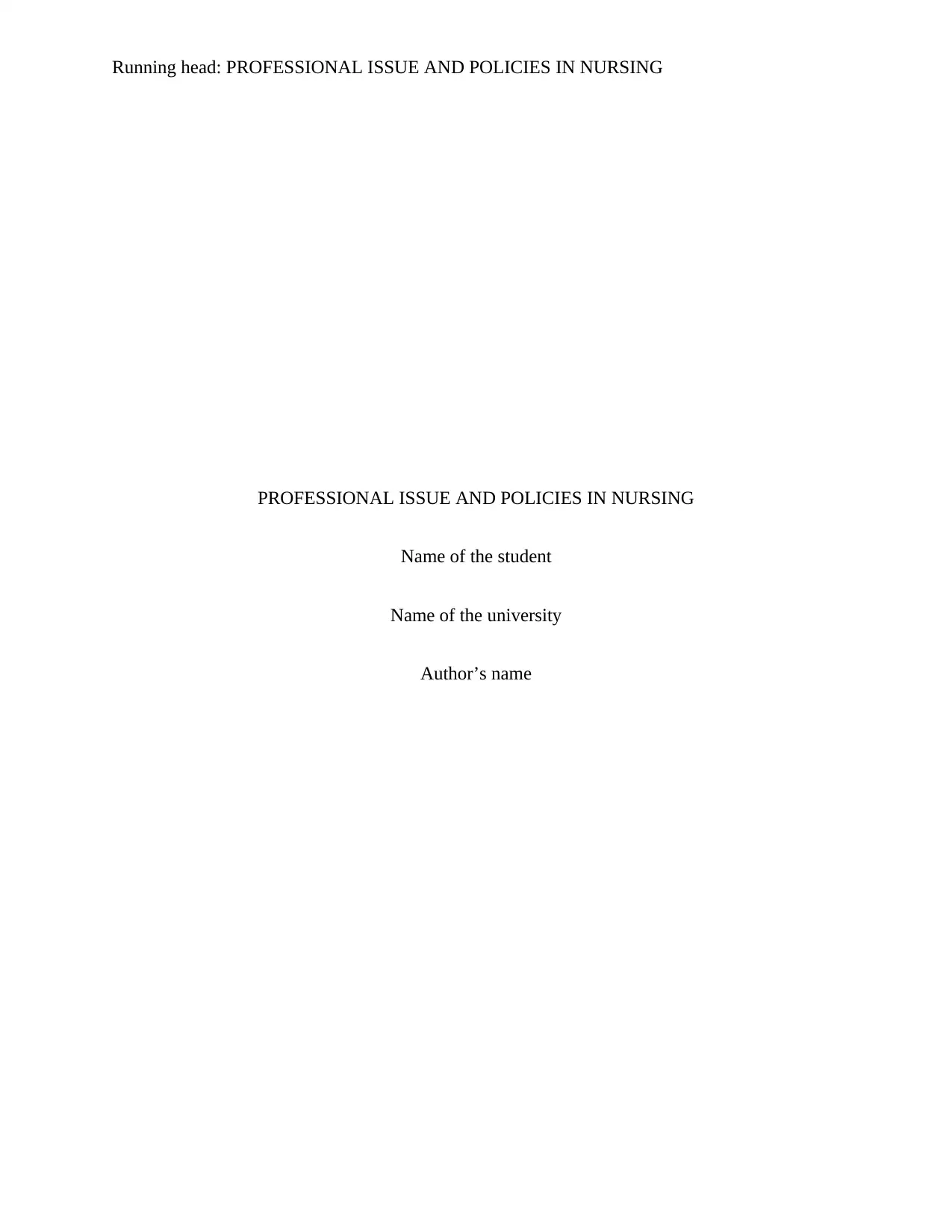
Running head: PROFESSIONAL ISSUE AND POLICIES IN NURSING
PROFESSIONAL ISSUE AND POLICIES IN NURSING
Name of the student
Name of the university
Author’s name
PROFESSIONAL ISSUE AND POLICIES IN NURSING
Name of the student
Name of the university
Author’s name
Paraphrase This Document
Need a fresh take? Get an instant paraphrase of this document with our AI Paraphraser
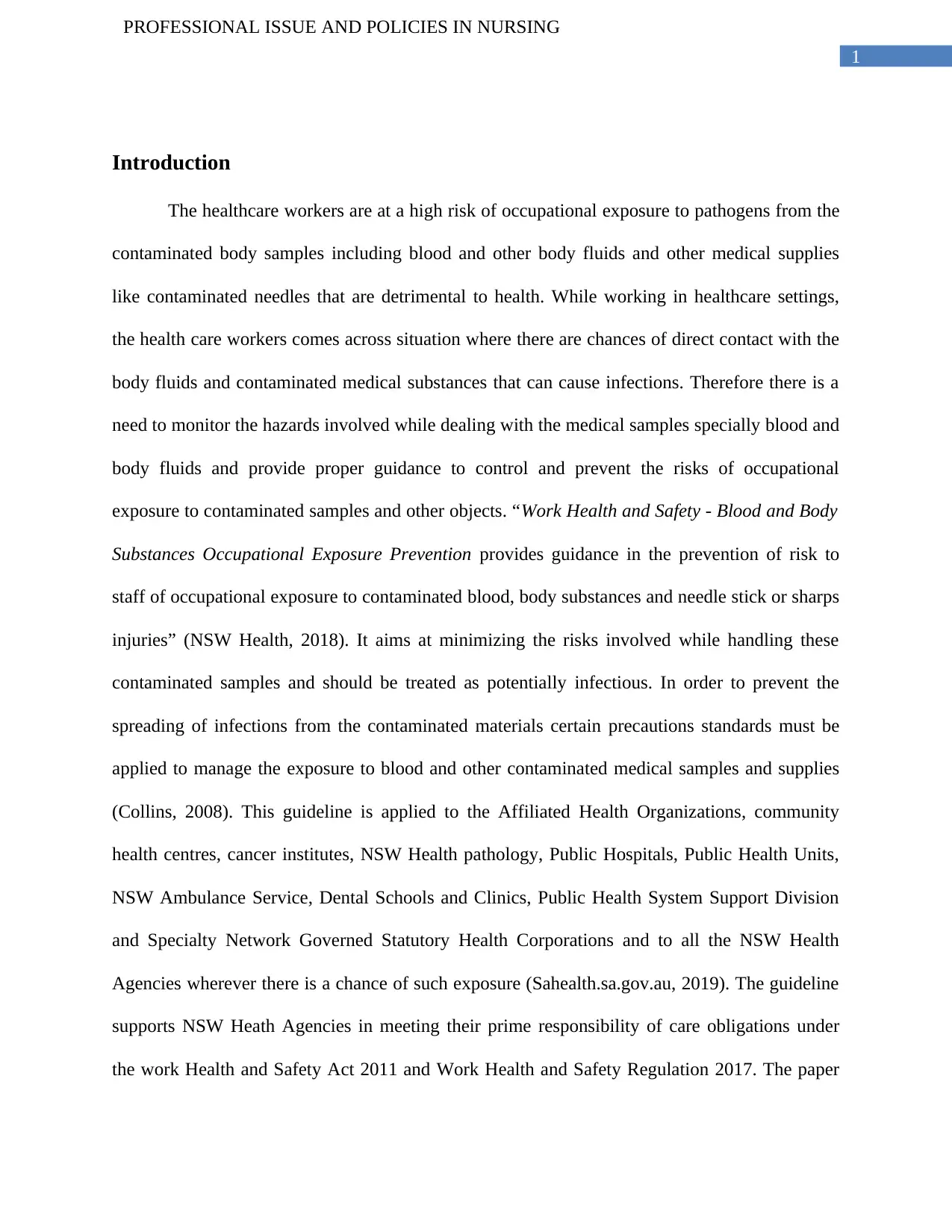
1
PROFESSIONAL ISSUE AND POLICIES IN NURSING
Introduction
The healthcare workers are at a high risk of occupational exposure to pathogens from the
contaminated body samples including blood and other body fluids and other medical supplies
like contaminated needles that are detrimental to health. While working in healthcare settings,
the health care workers comes across situation where there are chances of direct contact with the
body fluids and contaminated medical substances that can cause infections. Therefore there is a
need to monitor the hazards involved while dealing with the medical samples specially blood and
body fluids and provide proper guidance to control and prevent the risks of occupational
exposure to contaminated samples and other objects. “Work Health and Safety - Blood and Body
Substances Occupational Exposure Prevention provides guidance in the prevention of risk to
staff of occupational exposure to contaminated blood, body substances and needle stick or sharps
injuries” (NSW Health, 2018). It aims at minimizing the risks involved while handling these
contaminated samples and should be treated as potentially infectious. In order to prevent the
spreading of infections from the contaminated materials certain precautions standards must be
applied to manage the exposure to blood and other contaminated medical samples and supplies
(Collins, 2008). This guideline is applied to the Affiliated Health Organizations, community
health centres, cancer institutes, NSW Health pathology, Public Hospitals, Public Health Units,
NSW Ambulance Service, Dental Schools and Clinics, Public Health System Support Division
and Specialty Network Governed Statutory Health Corporations and to all the NSW Health
Agencies wherever there is a chance of such exposure (Sahealth.sa.gov.au, 2019). The guideline
supports NSW Heath Agencies in meeting their prime responsibility of care obligations under
the work Health and Safety Act 2011 and Work Health and Safety Regulation 2017. The paper
PROFESSIONAL ISSUE AND POLICIES IN NURSING
Introduction
The healthcare workers are at a high risk of occupational exposure to pathogens from the
contaminated body samples including blood and other body fluids and other medical supplies
like contaminated needles that are detrimental to health. While working in healthcare settings,
the health care workers comes across situation where there are chances of direct contact with the
body fluids and contaminated medical substances that can cause infections. Therefore there is a
need to monitor the hazards involved while dealing with the medical samples specially blood and
body fluids and provide proper guidance to control and prevent the risks of occupational
exposure to contaminated samples and other objects. “Work Health and Safety - Blood and Body
Substances Occupational Exposure Prevention provides guidance in the prevention of risk to
staff of occupational exposure to contaminated blood, body substances and needle stick or sharps
injuries” (NSW Health, 2018). It aims at minimizing the risks involved while handling these
contaminated samples and should be treated as potentially infectious. In order to prevent the
spreading of infections from the contaminated materials certain precautions standards must be
applied to manage the exposure to blood and other contaminated medical samples and supplies
(Collins, 2008). This guideline is applied to the Affiliated Health Organizations, community
health centres, cancer institutes, NSW Health pathology, Public Hospitals, Public Health Units,
NSW Ambulance Service, Dental Schools and Clinics, Public Health System Support Division
and Specialty Network Governed Statutory Health Corporations and to all the NSW Health
Agencies wherever there is a chance of such exposure (Sahealth.sa.gov.au, 2019). The guideline
supports NSW Heath Agencies in meeting their prime responsibility of care obligations under
the work Health and Safety Act 2011 and Work Health and Safety Regulation 2017. The paper
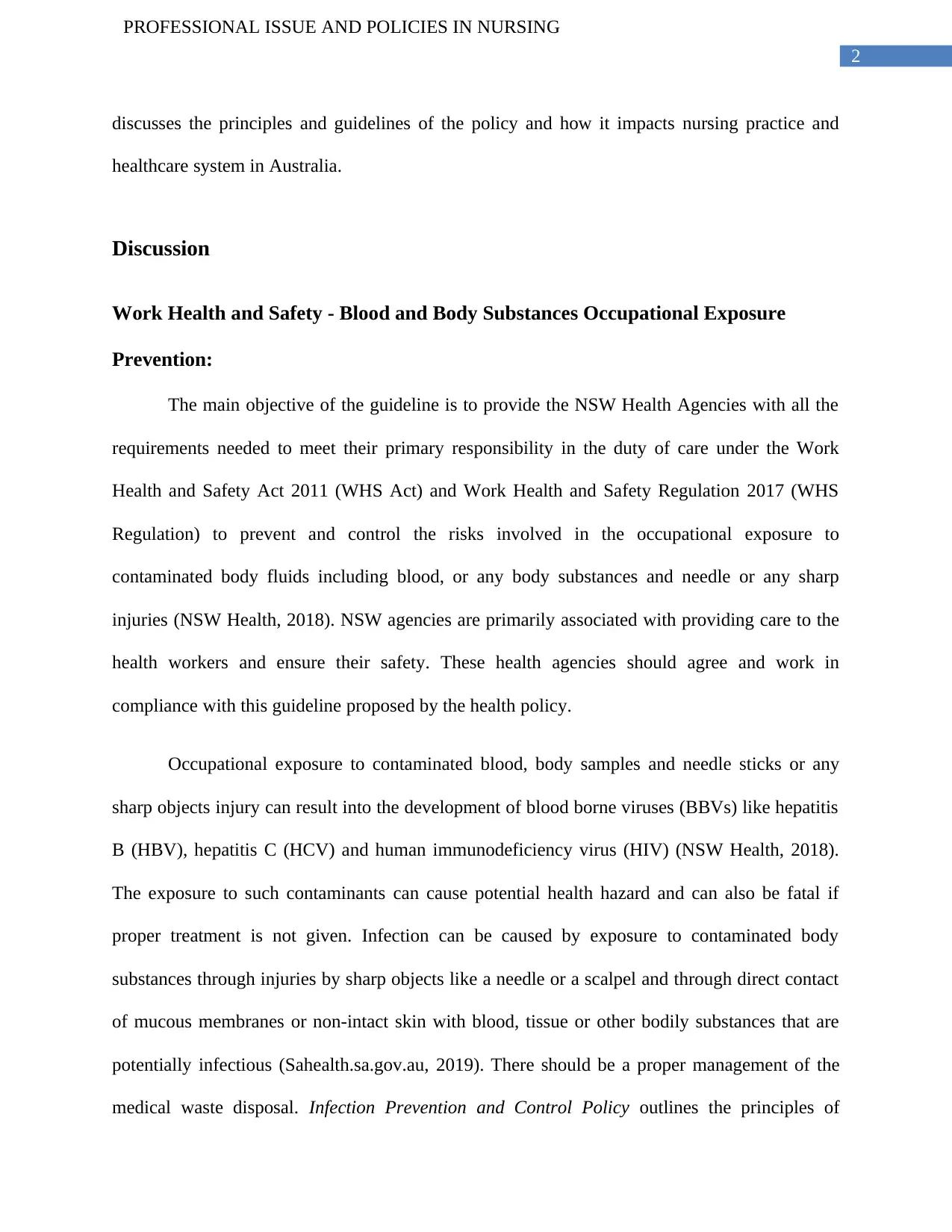
2
PROFESSIONAL ISSUE AND POLICIES IN NURSING
discusses the principles and guidelines of the policy and how it impacts nursing practice and
healthcare system in Australia.
Discussion
Work Health and Safety - Blood and Body Substances Occupational Exposure
Prevention:
The main objective of the guideline is to provide the NSW Health Agencies with all the
requirements needed to meet their primary responsibility in the duty of care under the Work
Health and Safety Act 2011 (WHS Act) and Work Health and Safety Regulation 2017 (WHS
Regulation) to prevent and control the risks involved in the occupational exposure to
contaminated body fluids including blood, or any body substances and needle or any sharp
injuries (NSW Health, 2018). NSW agencies are primarily associated with providing care to the
health workers and ensure their safety. These health agencies should agree and work in
compliance with this guideline proposed by the health policy.
Occupational exposure to contaminated blood, body samples and needle sticks or any
sharp objects injury can result into the development of blood borne viruses (BBVs) like hepatitis
B (HBV), hepatitis C (HCV) and human immunodeficiency virus (HIV) (NSW Health, 2018).
The exposure to such contaminants can cause potential health hazard and can also be fatal if
proper treatment is not given. Infection can be caused by exposure to contaminated body
substances through injuries by sharp objects like a needle or a scalpel and through direct contact
of mucous membranes or non-intact skin with blood, tissue or other bodily substances that are
potentially infectious (Sahealth.sa.gov.au, 2019). There should be a proper management of the
medical waste disposal. Infection Prevention and Control Policy outlines the principles of
PROFESSIONAL ISSUE AND POLICIES IN NURSING
discusses the principles and guidelines of the policy and how it impacts nursing practice and
healthcare system in Australia.
Discussion
Work Health and Safety - Blood and Body Substances Occupational Exposure
Prevention:
The main objective of the guideline is to provide the NSW Health Agencies with all the
requirements needed to meet their primary responsibility in the duty of care under the Work
Health and Safety Act 2011 (WHS Act) and Work Health and Safety Regulation 2017 (WHS
Regulation) to prevent and control the risks involved in the occupational exposure to
contaminated body fluids including blood, or any body substances and needle or any sharp
injuries (NSW Health, 2018). NSW agencies are primarily associated with providing care to the
health workers and ensure their safety. These health agencies should agree and work in
compliance with this guideline proposed by the health policy.
Occupational exposure to contaminated blood, body samples and needle sticks or any
sharp objects injury can result into the development of blood borne viruses (BBVs) like hepatitis
B (HBV), hepatitis C (HCV) and human immunodeficiency virus (HIV) (NSW Health, 2018).
The exposure to such contaminants can cause potential health hazard and can also be fatal if
proper treatment is not given. Infection can be caused by exposure to contaminated body
substances through injuries by sharp objects like a needle or a scalpel and through direct contact
of mucous membranes or non-intact skin with blood, tissue or other bodily substances that are
potentially infectious (Sahealth.sa.gov.au, 2019). There should be a proper management of the
medical waste disposal. Infection Prevention and Control Policy outlines the principles of
⊘ This is a preview!⊘
Do you want full access?
Subscribe today to unlock all pages.

Trusted by 1+ million students worldwide
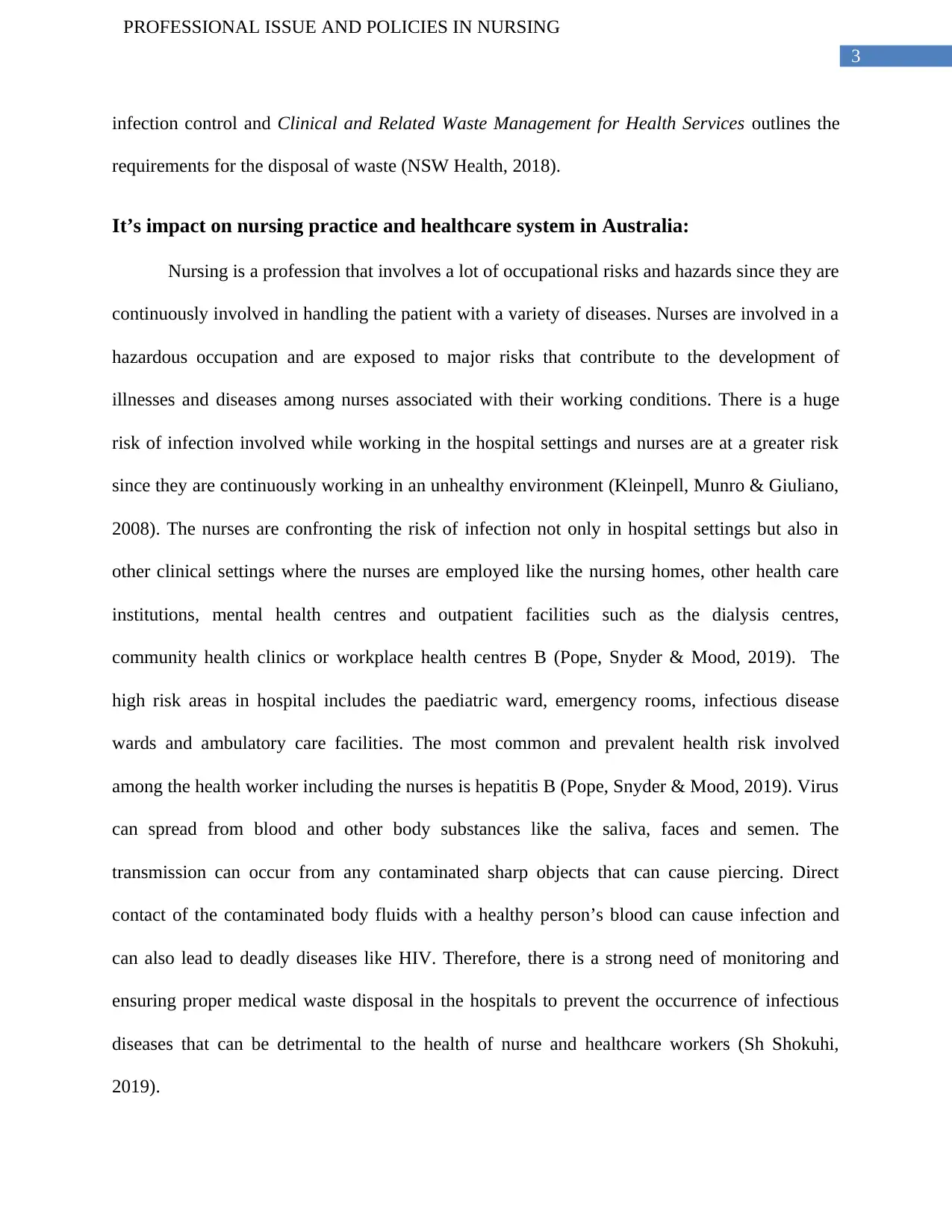
3
PROFESSIONAL ISSUE AND POLICIES IN NURSING
infection control and Clinical and Related Waste Management for Health Services outlines the
requirements for the disposal of waste (NSW Health, 2018).
It’s impact on nursing practice and healthcare system in Australia:
Nursing is a profession that involves a lot of occupational risks and hazards since they are
continuously involved in handling the patient with a variety of diseases. Nurses are involved in a
hazardous occupation and are exposed to major risks that contribute to the development of
illnesses and diseases among nurses associated with their working conditions. There is a huge
risk of infection involved while working in the hospital settings and nurses are at a greater risk
since they are continuously working in an unhealthy environment (Kleinpell, Munro & Giuliano,
2008). The nurses are confronting the risk of infection not only in hospital settings but also in
other clinical settings where the nurses are employed like the nursing homes, other health care
institutions, mental health centres and outpatient facilities such as the dialysis centres,
community health clinics or workplace health centres B (Pope, Snyder & Mood, 2019). The
high risk areas in hospital includes the paediatric ward, emergency rooms, infectious disease
wards and ambulatory care facilities. The most common and prevalent health risk involved
among the health worker including the nurses is hepatitis B (Pope, Snyder & Mood, 2019). Virus
can spread from blood and other body substances like the saliva, faces and semen. The
transmission can occur from any contaminated sharp objects that can cause piercing. Direct
contact of the contaminated body fluids with a healthy person’s blood can cause infection and
can also lead to deadly diseases like HIV. Therefore, there is a strong need of monitoring and
ensuring proper medical waste disposal in the hospitals to prevent the occurrence of infectious
diseases that can be detrimental to the health of nurse and healthcare workers (Sh Shokuhi,
2019).
PROFESSIONAL ISSUE AND POLICIES IN NURSING
infection control and Clinical and Related Waste Management for Health Services outlines the
requirements for the disposal of waste (NSW Health, 2018).
It’s impact on nursing practice and healthcare system in Australia:
Nursing is a profession that involves a lot of occupational risks and hazards since they are
continuously involved in handling the patient with a variety of diseases. Nurses are involved in a
hazardous occupation and are exposed to major risks that contribute to the development of
illnesses and diseases among nurses associated with their working conditions. There is a huge
risk of infection involved while working in the hospital settings and nurses are at a greater risk
since they are continuously working in an unhealthy environment (Kleinpell, Munro & Giuliano,
2008). The nurses are confronting the risk of infection not only in hospital settings but also in
other clinical settings where the nurses are employed like the nursing homes, other health care
institutions, mental health centres and outpatient facilities such as the dialysis centres,
community health clinics or workplace health centres B (Pope, Snyder & Mood, 2019). The
high risk areas in hospital includes the paediatric ward, emergency rooms, infectious disease
wards and ambulatory care facilities. The most common and prevalent health risk involved
among the health worker including the nurses is hepatitis B (Pope, Snyder & Mood, 2019). Virus
can spread from blood and other body substances like the saliva, faces and semen. The
transmission can occur from any contaminated sharp objects that can cause piercing. Direct
contact of the contaminated body fluids with a healthy person’s blood can cause infection and
can also lead to deadly diseases like HIV. Therefore, there is a strong need of monitoring and
ensuring proper medical waste disposal in the hospitals to prevent the occurrence of infectious
diseases that can be detrimental to the health of nurse and healthcare workers (Sh Shokuhi,
2019).
Paraphrase This Document
Need a fresh take? Get an instant paraphrase of this document with our AI Paraphraser

4
PROFESSIONAL ISSUE AND POLICIES IN NURSING
Work health and safety – blood and body substance Occupational exposure prevention is
developed with the aim to prevent these kind of health hazards involved in working practice of
the nurses and health workers and have certain guidelines needed to be implemented in order to
achieve the desired outcome. This policy ensures the agencies to supervise and monitor through
its officers and managers to have a Sharps Injury Prevention Program, encourage the workers to
prevent any kinds of hazards associated with occupational exposure by identifying and reporting
them, to have evidences on vaccination in the place for health workers who are at potential risk
of attaining health hazards due to the transmission of pathogen from contaminated body
substances (Sahealth.sa.gov.au, 2019). They should be in charge of bringing into effect the
systems and programs implemented to make the workers aware of using standard precautions
while working in such settings. The workers must be given proper education regarding the
occupational as well non-occupational hazards due to blood borne viruses (Sh Shokuhi, 2019).
They should incorporate a strategy to ensure mandatory reporting of body substance exposure
and sharp injuries (Sahealth.sa.gov.au, 2019).
Nurses are responsible for taking care of a variety of patients suffering from both acute
and chronic illnesses and it is the primary responsibility of the nurses to deliver quality care to
the patient. While taking care of the patient especially in the surgical ward they often come
across such situation where there a chance of developing such infections (Collins, 2008).
Therefore, to restore their health and prevent the occurrence of such exposure, this policy must
be implemented that will reduce the chances of getting such infections of the health workers and
nurses, thereby, increasing and upholding the hospitals care delivery system. The framework of
the Healthcare system encompasses the contribution of healthcare practitioners, healthcare
workers and nurses to ensure proper delivery of treatment and care to the patients which can be
PROFESSIONAL ISSUE AND POLICIES IN NURSING
Work health and safety – blood and body substance Occupational exposure prevention is
developed with the aim to prevent these kind of health hazards involved in working practice of
the nurses and health workers and have certain guidelines needed to be implemented in order to
achieve the desired outcome. This policy ensures the agencies to supervise and monitor through
its officers and managers to have a Sharps Injury Prevention Program, encourage the workers to
prevent any kinds of hazards associated with occupational exposure by identifying and reporting
them, to have evidences on vaccination in the place for health workers who are at potential risk
of attaining health hazards due to the transmission of pathogen from contaminated body
substances (Sahealth.sa.gov.au, 2019). They should be in charge of bringing into effect the
systems and programs implemented to make the workers aware of using standard precautions
while working in such settings. The workers must be given proper education regarding the
occupational as well non-occupational hazards due to blood borne viruses (Sh Shokuhi, 2019).
They should incorporate a strategy to ensure mandatory reporting of body substance exposure
and sharp injuries (Sahealth.sa.gov.au, 2019).
Nurses are responsible for taking care of a variety of patients suffering from both acute
and chronic illnesses and it is the primary responsibility of the nurses to deliver quality care to
the patient. While taking care of the patient especially in the surgical ward they often come
across such situation where there a chance of developing such infections (Collins, 2008).
Therefore, to restore their health and prevent the occurrence of such exposure, this policy must
be implemented that will reduce the chances of getting such infections of the health workers and
nurses, thereby, increasing and upholding the hospitals care delivery system. The framework of
the Healthcare system encompasses the contribution of healthcare practitioners, healthcare
workers and nurses to ensure proper delivery of treatment and care to the patients which can be

5
PROFESSIONAL ISSUE AND POLICIES IN NURSING
hampered due to such occupational hazards which will ultimately lead to downfall of the
healthcare organizations. The primary responsibly of the healthcare centres should be ensuring
the safety of the workers and employees and protecting them from any kind of potential hazards
that have detrimental effect on their health.
Clinical guidelines
Work Health and Safety - Blood and Body Substances Occupational Exposure
Prevention has key principles to meet their primary healthcare requirements and NSW Work
Health and Safety legislation in the prevention of risks associated with occupational exposure to
contaminated blood, body substances and needle stick or sharps injuries (Murphy, 2014). The
guideline applies to all NSW agencies where there is a potential risk of occurrence of
occupational hazards due to exposure to contaminated medical substances and materials (NSW
Health, 2018).
The guideline of the policy provides the practical guidance using a risk management
approach to prevent and control work related exposure to infectious diseases by identifying the
hazards and preventing them by taking precautions to ensure a safe environment for all workers
of South wale health services and consumers (NSW Health, 2018).
The guideline ensures the following strategies to ensure prevention of heath care workers due
to occupational hazards:
Developing a Sharp Injury Prevention Program to protect the health workers, patients and
members of the community.
Ensuring vaccination programs and evidences among the health care workers who are
involved and are at risk of such hazards.
PROFESSIONAL ISSUE AND POLICIES IN NURSING
hampered due to such occupational hazards which will ultimately lead to downfall of the
healthcare organizations. The primary responsibly of the healthcare centres should be ensuring
the safety of the workers and employees and protecting them from any kind of potential hazards
that have detrimental effect on their health.
Clinical guidelines
Work Health and Safety - Blood and Body Substances Occupational Exposure
Prevention has key principles to meet their primary healthcare requirements and NSW Work
Health and Safety legislation in the prevention of risks associated with occupational exposure to
contaminated blood, body substances and needle stick or sharps injuries (Murphy, 2014). The
guideline applies to all NSW agencies where there is a potential risk of occurrence of
occupational hazards due to exposure to contaminated medical substances and materials (NSW
Health, 2018).
The guideline of the policy provides the practical guidance using a risk management
approach to prevent and control work related exposure to infectious diseases by identifying the
hazards and preventing them by taking precautions to ensure a safe environment for all workers
of South wale health services and consumers (NSW Health, 2018).
The guideline ensures the following strategies to ensure prevention of heath care workers due
to occupational hazards:
Developing a Sharp Injury Prevention Program to protect the health workers, patients and
members of the community.
Ensuring vaccination programs and evidences among the health care workers who are
involved and are at risk of such hazards.
⊘ This is a preview!⊘
Do you want full access?
Subscribe today to unlock all pages.

Trusted by 1+ million students worldwide

6
PROFESSIONAL ISSUE AND POLICIES IN NURSING
To monitor and ensure that a system aiming to manage or control the occupational as
well as the on-occupational exposures to Blood Borne viruses.
Ensuring that a system is in its place and working properly towards maintaining the
mandatory reporting of sharp injuries and other blood and body substance exposures via
the facility’s Incident Management System.
Engaging the workers in identifying and reporting any hazards related to occupational
exposure and actively participating in elimination of such hazards and if not feasible,
minimizing the risk of exposure to the contaminants.
Implementing systems and programs for managing the workers and providing them with
information and creating awareness among them about their non-immune status.
To ensure that the workers who are at a high risk of occupational hazard and can be
directly impacted by such exposure receives proper education regarding the precautions
needed to be taken to reduce the chance of getting infected (NSW Health, 2018).
Conclusion
Health care providers while working in clinical and hospital settings are at a potential risk
of developing infections due to blood borne viruses and other pathogens from contaminated
blood and other body substances and also from contaminated needles and sharp objects or
instruments. Occupational exposure to body fluids occurs through mucous membrane exposure,
percutaneous injury, non-intact skin exposure and bites. Every individual working in the
healthcare setting including doctors, nurses, auxiliary health-care workers, laboratory
technicians, or students undertaking clinical training or gaining experience in health-care settings
are at a high risk of occupational hazards and can be exposed to infectious and hazardous
PROFESSIONAL ISSUE AND POLICIES IN NURSING
To monitor and ensure that a system aiming to manage or control the occupational as
well as the on-occupational exposures to Blood Borne viruses.
Ensuring that a system is in its place and working properly towards maintaining the
mandatory reporting of sharp injuries and other blood and body substance exposures via
the facility’s Incident Management System.
Engaging the workers in identifying and reporting any hazards related to occupational
exposure and actively participating in elimination of such hazards and if not feasible,
minimizing the risk of exposure to the contaminants.
Implementing systems and programs for managing the workers and providing them with
information and creating awareness among them about their non-immune status.
To ensure that the workers who are at a high risk of occupational hazard and can be
directly impacted by such exposure receives proper education regarding the precautions
needed to be taken to reduce the chance of getting infected (NSW Health, 2018).
Conclusion
Health care providers while working in clinical and hospital settings are at a potential risk
of developing infections due to blood borne viruses and other pathogens from contaminated
blood and other body substances and also from contaminated needles and sharp objects or
instruments. Occupational exposure to body fluids occurs through mucous membrane exposure,
percutaneous injury, non-intact skin exposure and bites. Every individual working in the
healthcare setting including doctors, nurses, auxiliary health-care workers, laboratory
technicians, or students undertaking clinical training or gaining experience in health-care settings
are at a high risk of occupational hazards and can be exposed to infectious and hazardous
Paraphrase This Document
Need a fresh take? Get an instant paraphrase of this document with our AI Paraphraser
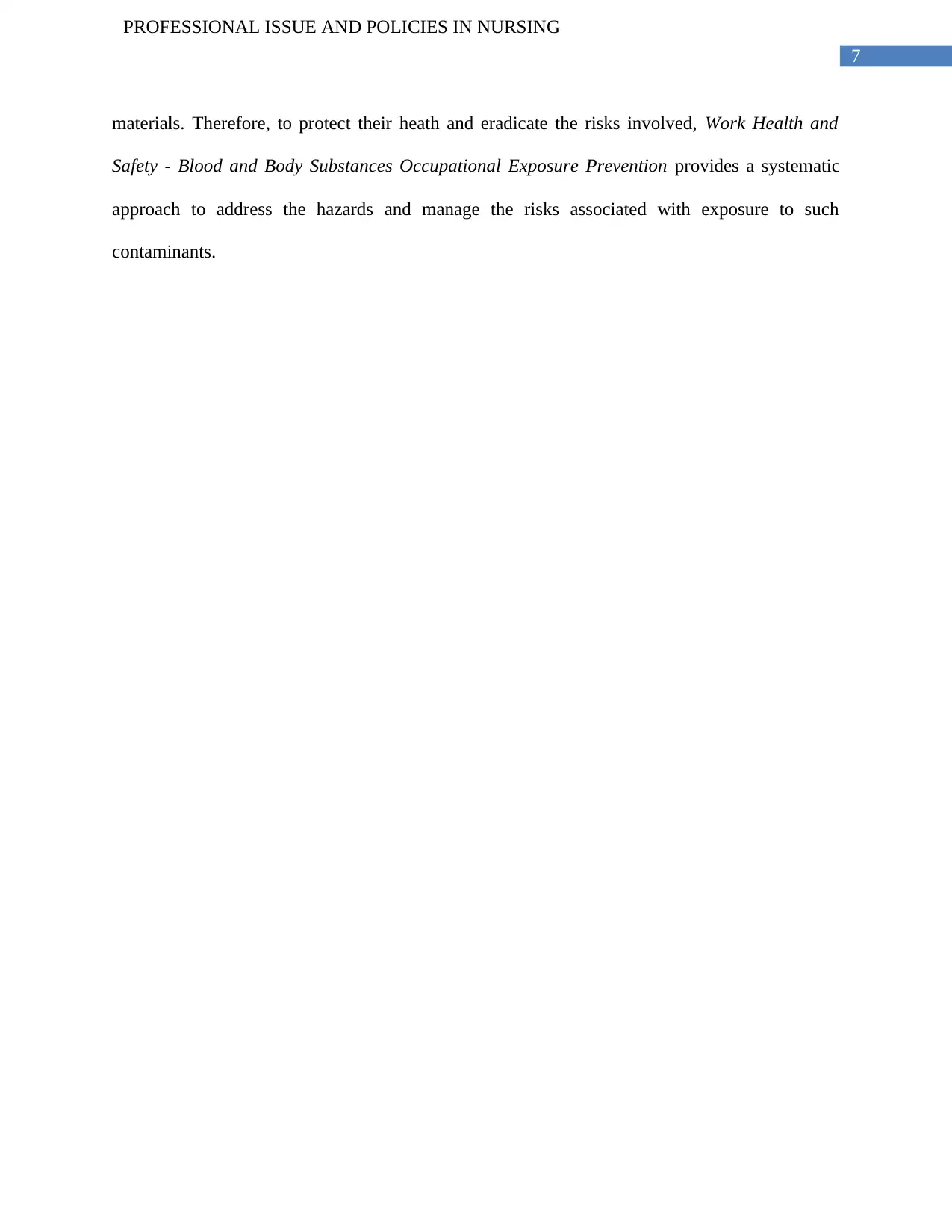
7
PROFESSIONAL ISSUE AND POLICIES IN NURSING
materials. Therefore, to protect their heath and eradicate the risks involved, Work Health and
Safety - Blood and Body Substances Occupational Exposure Prevention provides a systematic
approach to address the hazards and manage the risks associated with exposure to such
contaminants.
PROFESSIONAL ISSUE AND POLICIES IN NURSING
materials. Therefore, to protect their heath and eradicate the risks involved, Work Health and
Safety - Blood and Body Substances Occupational Exposure Prevention provides a systematic
approach to address the hazards and manage the risks associated with exposure to such
contaminants.
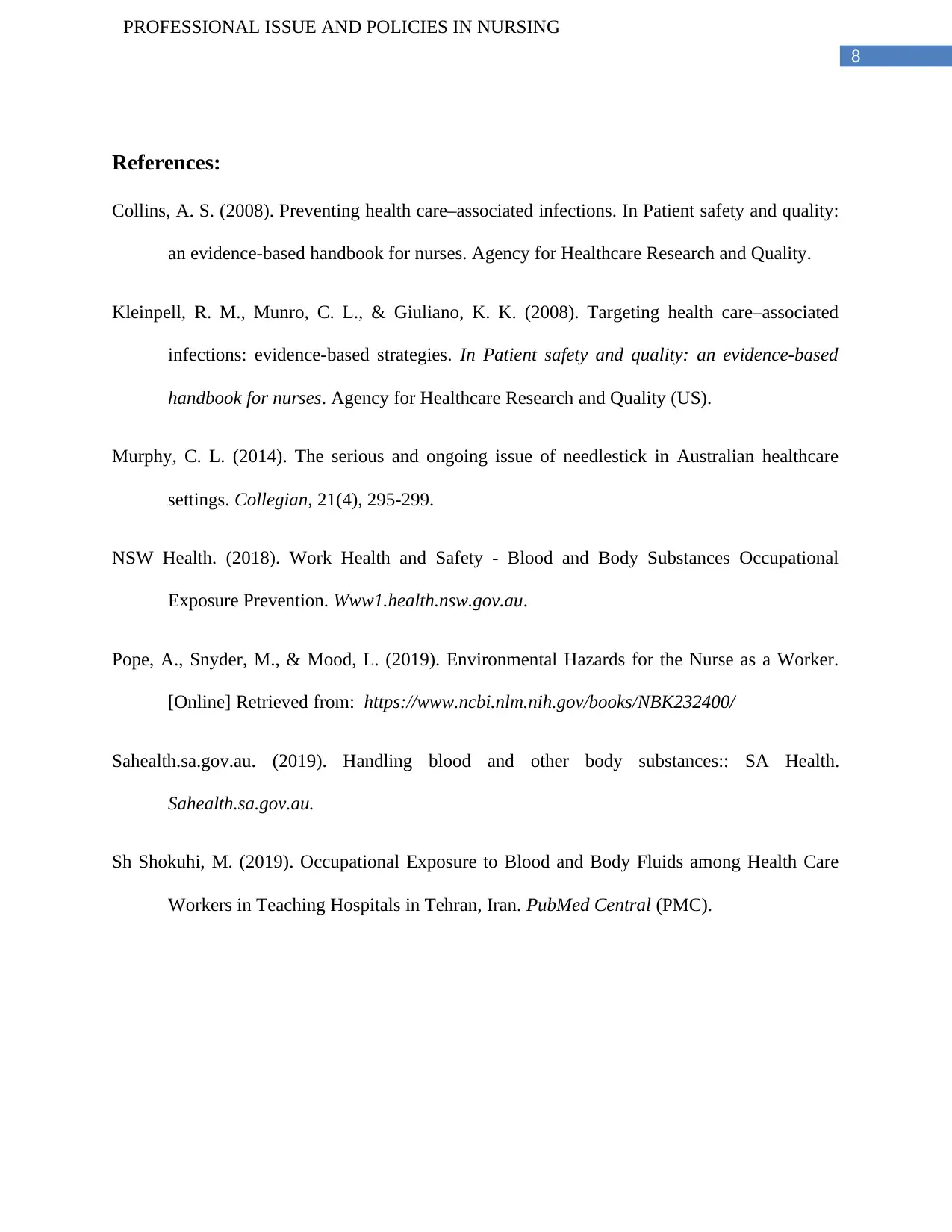
8
PROFESSIONAL ISSUE AND POLICIES IN NURSING
References:
Collins, A. S. (2008). Preventing health care–associated infections. In Patient safety and quality:
an evidence-based handbook for nurses. Agency for Healthcare Research and Quality.
Kleinpell, R. M., Munro, C. L., & Giuliano, K. K. (2008). Targeting health care–associated
infections: evidence-based strategies. In Patient safety and quality: an evidence-based
handbook for nurses. Agency for Healthcare Research and Quality (US).
Murphy, C. L. (2014). The serious and ongoing issue of needlestick in Australian healthcare
settings. Collegian, 21(4), 295-299.
NSW Health. (2018). Work Health and Safety - Blood and Body Substances Occupational
Exposure Prevention. Www1.health.nsw.gov.au.
Pope, A., Snyder, M., & Mood, L. (2019). Environmental Hazards for the Nurse as a Worker.
[Online] Retrieved from: https://www.ncbi.nlm.nih.gov/books/NBK232400/
Sahealth.sa.gov.au. (2019). Handling blood and other body substances:: SA Health.
Sahealth.sa.gov.au.
Sh Shokuhi, M. (2019). Occupational Exposure to Blood and Body Fluids among Health Care
Workers in Teaching Hospitals in Tehran, Iran. PubMed Central (PMC).
PROFESSIONAL ISSUE AND POLICIES IN NURSING
References:
Collins, A. S. (2008). Preventing health care–associated infections. In Patient safety and quality:
an evidence-based handbook for nurses. Agency for Healthcare Research and Quality.
Kleinpell, R. M., Munro, C. L., & Giuliano, K. K. (2008). Targeting health care–associated
infections: evidence-based strategies. In Patient safety and quality: an evidence-based
handbook for nurses. Agency for Healthcare Research and Quality (US).
Murphy, C. L. (2014). The serious and ongoing issue of needlestick in Australian healthcare
settings. Collegian, 21(4), 295-299.
NSW Health. (2018). Work Health and Safety - Blood and Body Substances Occupational
Exposure Prevention. Www1.health.nsw.gov.au.
Pope, A., Snyder, M., & Mood, L. (2019). Environmental Hazards for the Nurse as a Worker.
[Online] Retrieved from: https://www.ncbi.nlm.nih.gov/books/NBK232400/
Sahealth.sa.gov.au. (2019). Handling blood and other body substances:: SA Health.
Sahealth.sa.gov.au.
Sh Shokuhi, M. (2019). Occupational Exposure to Blood and Body Fluids among Health Care
Workers in Teaching Hospitals in Tehran, Iran. PubMed Central (PMC).
⊘ This is a preview!⊘
Do you want full access?
Subscribe today to unlock all pages.

Trusted by 1+ million students worldwide
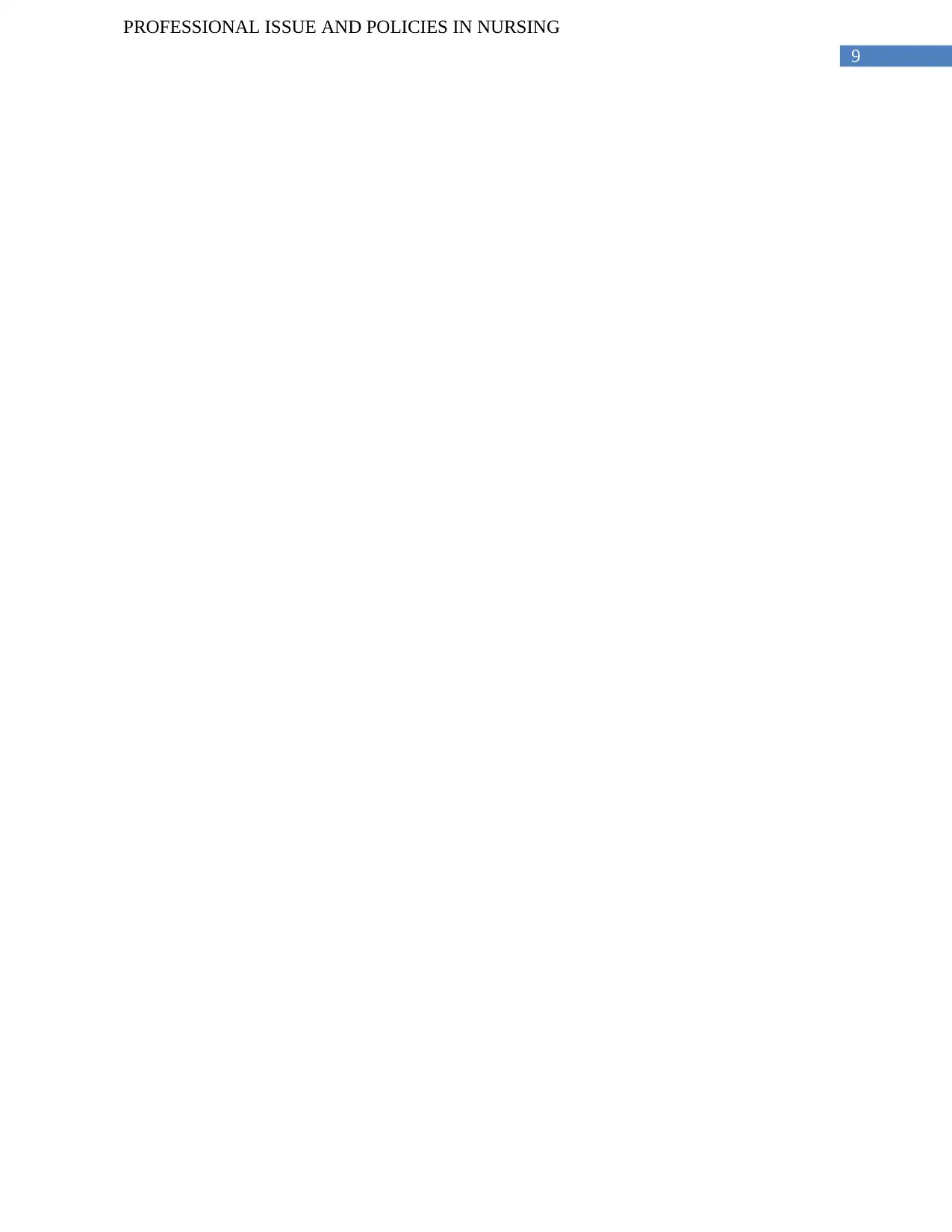
9
PROFESSIONAL ISSUE AND POLICIES IN NURSING
PROFESSIONAL ISSUE AND POLICIES IN NURSING
1 out of 10
Related Documents
Your All-in-One AI-Powered Toolkit for Academic Success.
+13062052269
info@desklib.com
Available 24*7 on WhatsApp / Email
![[object Object]](/_next/static/media/star-bottom.7253800d.svg)
Unlock your academic potential
Copyright © 2020–2025 A2Z Services. All Rights Reserved. Developed and managed by ZUCOL.





